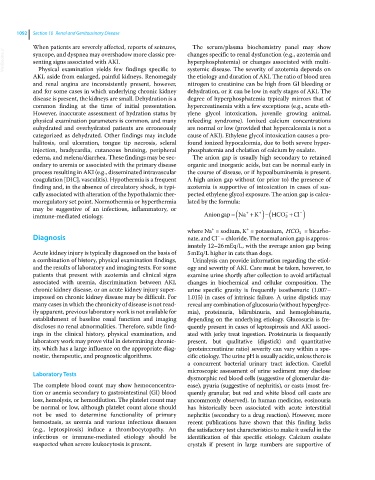Page 1154 - Clinical Small Animal Internal Medicine
P. 1154
1092 Section 10 Renal and Genitourinary Disease
When patients are severely affected, reports of seizures, The serum/plasma biochemistry panel may show
VetBooks.ir syncope, and dyspnea may overshadow more classic pre- changes specific to renal dysfunction (e.g., azotemia and
hyperphosphatemia) or changes associated with multi-
senting signs associated with AKI.
Physical examination yields few findings specific to
the etiology and duration of AKI. The ratio of blood urea
AKI, aside from enlarged, painful kidneys. Renomegaly systemic disease. The severity of azotemia depends on
and renal angina are inconsistently present, however, nitrogen to creatinine can be high from GI bleeding or
and for some cases in which underlying chronic kidney dehydration, or it can be low in early stages of AKI. The
disease is present, the kidneys are small. Dehydration is a degree of hyperphosphatemia typically mirrors that of
common finding at the time of initial presentation. hypercreatinemia with a few exceptions (e.g., acute eth-
However, inaccurate assessment of hydration status by ylene glycol intoxication, juvenile growing animal,
physical examination parameters is common, and many refeeding syndrome). Ionized calcium concentrations
euhydrated and overhydrated patients are erroneously are normal or low (provided that hypercalcemia is not a
categorized as dehydrated. Other findings may include cause of AKI). Ethylene glycol intoxication causes a pro-
halitosis, oral ulceration, tongue tip necrosis, scleral found ionized hypocalcemia, due to both severe hyper-
injection, bradycardia, cutaneous bruising, peripheral phosphatemia and chelation of calcium by oxalate.
edema, and melena/diarrhea. These findings may be sec- The anion gap is usually high secondary to retained
ondary to uremia or associated with the primary disease organic and inorganic acids, but can be normal early in
process resulting in AKI (e.g., disseminated intravascular the course of disease, or if hypoalbuminemia is present.
coagulation [DIC], vasculitis). Hypothermia is a frequent A high anion gap without (or prior to) the presence of
finding and, in the absence of circulatory shock, is typi- azotemia is supportive of intoxication in cases of sus-
cally associated with alteration of the hypothalamic ther- pected ethylene glycol exposure. The anion gap is calcu-
moregulatory set point. Normothermia or hyperthermia lated by the formula:
may be suggestive of an infectious, inflammatory, or
immune‐mediated etiology. Anion gap Na K HCO 3 Cl
+
+
where Na = sodium, K = potassium, HCO 3 = bicarbo-
Diagnosis nate, and Cl = chloride. The normal anion gap is approx-
–
imately 12–26 mEq/L, with the average anion gap being
Acute kidney injury is typically diagnosed on the basis of 5 mEq/L higher in cats than dogs.
a combination of history, physical examination findings, Urinalysis can provide information regarding the etiol-
and the results of laboratory and imaging tests. For some ogy and severity of AKI. Care must be taken, however, to
patients that present with azotemia and clinical signs examine urine shortly after collection to avoid artifactual
associated with uremia, discrimination between AKI, changes in biochemical and cellular composition. The
chronic kidney disease, or an acute kidney injury super- urine specific gravity is frequently isosthenuric (1.007–
imposed on chronic kidney disease may be difficult. For 1.015) in cases of intrinsic failure. A urine dipstick may
many cases in which the chronicity of disease is not read- reveal any combination of glucosuria (without hyperglyce-
ily apparent, previous laboratory work is not available for mia), proteinuria, bilirubinuria, and hemoglobinuria,
establishment of baseline renal function and imaging depending on the underlying etiology. Glucosuria is fre-
discloses no renal abnormalities. Therefore, subtle find- quently present in cases of leptospirosis and AKI associ-
ings in the clinical history, physical examination, and ated with jerky treat ingestion. Proteinuria is frequently
laboratory work may prove vital in determining chronic- present, but qualitative (dipstick) and quantitative
ity, which has a large influence on the appropriate diag- (protein:creatinine ratio) severity can vary within a spe-
nostic, therapeutic, and prognostic algorithms. cific etiology. The urine pH is usually acidic, unless there is
a concurrent bacterial urinary tract infection. Careful
microscopic assessment of urine sediment may disclose
Laboratory Tests
dysmorphic red blood cells (suggestive of glomerular dis-
The complete blood count may show hemoconcentra- ease), pyuria (suggestive of nephritis), or casts (most fre-
tion or anemia secondary to gastrointestinal (GI) blood quently granular, but red and white blood cell casts are
loss, hemolysis, or hemodilution. The platelet count may uncommonly observed). In human medicine, eosinouria
be normal or low, although platelet count alone should has historically been associated with acute interstitial
not be used to determine functionality of primary nephritis (secondary to a drug reaction). However, more
hemostasis, as uremia and various infectious diseases recent publications have shown that this finding lacks
(e.g., leptospirosis) induce a thrombocytopathy. An the satisfactory test characteristics to make it useful in the
infectious or immune-mediated etiology should be identification of this specific etiology. Calcium oxalate
suspected when severe leukocytosis is present. crystals if present in large numbers are supportive of

